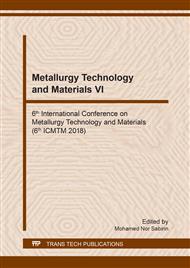[1]
J.K. Cochran, Ceramic hollow spheres and their applications, Curr. Opin. Solid State Mater. Sci. 3 (1998) 474-479.
Google Scholar
[2]
Y. Liao, X. Wu, H. Liu, Y. Chen, Thermal conductivity of powder silica hollow spheres, Thermochim. Acta 526 (2011) 178-184.
DOI: 10.1016/j.tca.2011.09.011
Google Scholar
[3]
J. Manuel, J.G. Blanco, K.L. Marquez, Field application of glass bubbles as a density-reducing agent, SPE 62899, (2000).
Google Scholar
[4]
J. Blanco, F. Ramirez, F. Mata, A. Ojeda, B. Atencio, Field application of glass bubbles as a density reducing agent in an oil base drilling fluid for marginal/low-permeability/low-pressure reservoirs, SPE Gas Technology Symposium, (2002).
DOI: 10.2118/75508-ms
Google Scholar
[5]
H. Zhang, J. Wu, L. Zhou, D. Zhang, L. Qi, Facile synthesis of monodisperse microspheres and gigantic hollow shells of mesoporous silica in mixed water−ethanol solvents, Langmuir, 23 (2006) 1107-1113.
DOI: 10.1021/la062542l
Google Scholar
[6]
X. Cheng, S. Liu, L. Lu, X. Sui, V. Meynen, P. Cool, E.F. Vansant, J. Jiang, Fast fabrication of hollow silica spheres with thermally stable nanoporous shells, Micropor. Mesopor. Mat. 98 (2007) 41-46.
DOI: 10.1016/j.micromeso.2006.08.014
Google Scholar
[7]
X.F. Wu, H.R. Lu, Z.Q. Wang, X.H. Xu, Preparation of hollow silica beads via soft template calcinating route, J. Sol-Gel Sci. Technol. 54 (2010) 147-153.
DOI: 10.1007/s10971-010-2169-x
Google Scholar
[8]
F. Caruso, Hollow capsule processing through colloidal templating and self-assembly, Chem- Eur. J. 6 (2000) 413-419.
DOI: 10.1002/(sici)1521-3765(20000204)6:3<413::aid-chem413>3.0.co;2-9
Google Scholar
[9]
M. Chen, L. Wu, S. Zhou, B. You, A Method for the fabrication of monodisperse hollow silica spheres, Adv. Mater. 18 (2006) 801-806.
DOI: 10.1002/adma.200501528
Google Scholar
[10]
K.D. Kim, K.Y. Choi, J.W. Yang, Formation of spherical hollow silica particles from sodium silicate solution by ultrasonic spray pyrolysis method, Colloids Surf. A, 254 (2005) 193-198.
DOI: 10.1016/j.colsurfa.2004.12.009
Google Scholar
[11]
W.S. Cheow, S. Li, K. Hadinoto, Spray drying formulation of hollow spherical aggregates of silica nanoparticles by experimental design, Chem. Eng. Res. Des. 88 (2010) 673-685.
DOI: 10.1016/j.cherd.2009.11.012
Google Scholar


